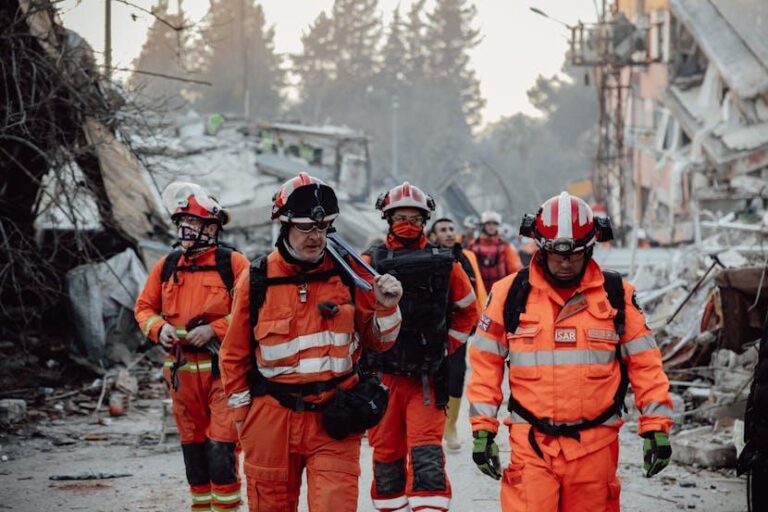Moderate Earthquake Hits San Diego, Heightening Awareness of Seismic Hazards
In the early hours last night, a 5.1 magnitude earthquake shook the vicinity of San Diego, California, disturbing residents and triggering immediate safety evaluations. The United States Geological Survey (USGS) confirmed the quake, which reverberated across the region, underscoring Southern California’s ongoing exposure to earthquake threats. Although no injuries have been reported, the event has prompted local officials and emergency teams to conduct thorough inspections of infrastructure, particularly focusing on older buildings and critical transportation routes vulnerable to seismic damage.
Authorities are advising the community to remain vigilant and revisit their earthquake preparedness strategies. Experts emphasize several precautionary steps to enhance safety:
- Anchor heavy furniture and appliances securely to walls to prevent tipping hazards
- Maintain accessible emergency kits stocked with essentials such as water, non-perishable food, and medical supplies
- Regularly practice earthquake drills like “Drop, Cover, and Hold On” to minimize injury during tremors
- Conduct post-quake inspections to identify any structural weaknesses or damages in homes
| Magnitude Range | Intensity Level | Recommended Safety Actions |
|---|---|---|
| 5.1 and above | Strong | Evacuation drills, Comprehensive damage assessments |
| 4.5 to 5.0 | Moderate | Secure household items, Stay updated with alerts |
| Below 4.5 | Mild | Remain informed, Perform minor safety checks |
Damage Evaluation and Community Impact Following San Diego Earthquake
The 5.1 magnitude tremor caused noticeable shaking across neighborhoods near San Diego, sparking concern but resulting in limited structural harm. Emergency teams documented minor cracks in older buildings lacking modern seismic reinforcements, along with scattered debris in some commercial areas. Temporary power outages affected multiple districts, though utility crews restored services promptly, minimizing inconvenience. Officials continue to monitor the situation closely, emphasizing the importance of preparedness for potential aftershocks.
Key Findings from Initial Damage Reports:
- Small fissures in residential walls and road surfaces
- Dislodged ceiling panels and unsecured items in business premises
- Brief interruptions in electricity and communication networks
- No serious injuries or fatalities confirmed to date
| Location | Type of Damage | Current Status |
|---|---|---|
| Downtown San Diego | Ceiling damage, power disruptions | Resolved |
| La Mesa | Wall cracks, ongoing structural assessments | Under Review |
| National City | Road debris clearance | Completed |
Coordinated Emergency Response Initiatives in San Diego
Following the earthquake, local authorities promptly activated emergency protocols to address immediate needs. Firefighters, paramedics, and police officers were deployed to evaluate damage, assist affected individuals, and secure hazardous zones. Emergency hotlines experienced a surge in calls, leading officials to expand communication channels to better serve the public. Several shelters and aid centers were opened throughout San Diego County to support residents displaced or concerned about structural safety.
Preventative measures were also enforced to reduce risks from aftershocks and secondary hazards. Schools temporarily closed to allow safety inspections, public transportation underwent operational checks, and vital infrastructure—including bridges and dams—was inspected without delay. An emergency operations center continues to coordinate response efforts, monitor seismic activity, and provide timely updates. Residents are encouraged to follow official advisories and maintain readiness until the situation stabilizes.
| Response Division | Actions Executed | Current Status |
|---|---|---|
| Fire & Rescue | Damage surveys, evacuation support | Active |
| Medical Services | On-site treatment, hospital coordination | Operational |
| Public Works | Infrastructure inspections, debris removal | In Progress |
| Law Enforcement | Traffic management, security patrols | Deployed |
| Communications | Public information dissemination | Ongoing |
Earthquake Preparedness Guidelines for Residents in Seismic Zones
Maintain awareness: It is crucial for residents to stay updated through reliable sources such as local news outlets, official government websites, and emergency alert systems. Utilizing multiple alert platforms—including smartphone apps, NOAA Weather Radio, and community notification networks—ensures timely receipt of critical information. Familiarity with safe locations within homes and workplaces can significantly improve response during an earthquake.
Prepare essential supplies: Assemble a comprehensive earthquake emergency kit containing at least a three-day supply of water (one gallon per person per day), non-perishable food, a flashlight with extra batteries, a first aid kit, and necessary medications. Family members should be well-informed about emergency plans, including designated meeting points and communication methods. Securing heavy furniture and appliances is also vital to minimize injury and property damage. The checklist below outlines recommended items for quick reference:
| Item | Suggested Quantity |
|---|---|
| Water | Minimum 1 gallon per person per day (3-day supply) |
| Non-perishable Food | 3-day supply |
| First Aid Kit | One complete kit |
| Flashlight and Batteries | Two sets |
| Emergency Contact List | One copy per family member |
Final Thoughts on the San Diego Earthquake and Ongoing Preparedness
As aftershocks continue to be closely observed, both residents and officials in the San Diego area remain alert following the 5.1 magnitude earthquake. While the event has not resulted in significant damage or casualties, it highlights the persistent seismic risks faced by California communities. This incident reinforces the critical need for continuous earthquake preparedness and public education. Updates will be provided as new information emerges to keep the public informed and safe.







